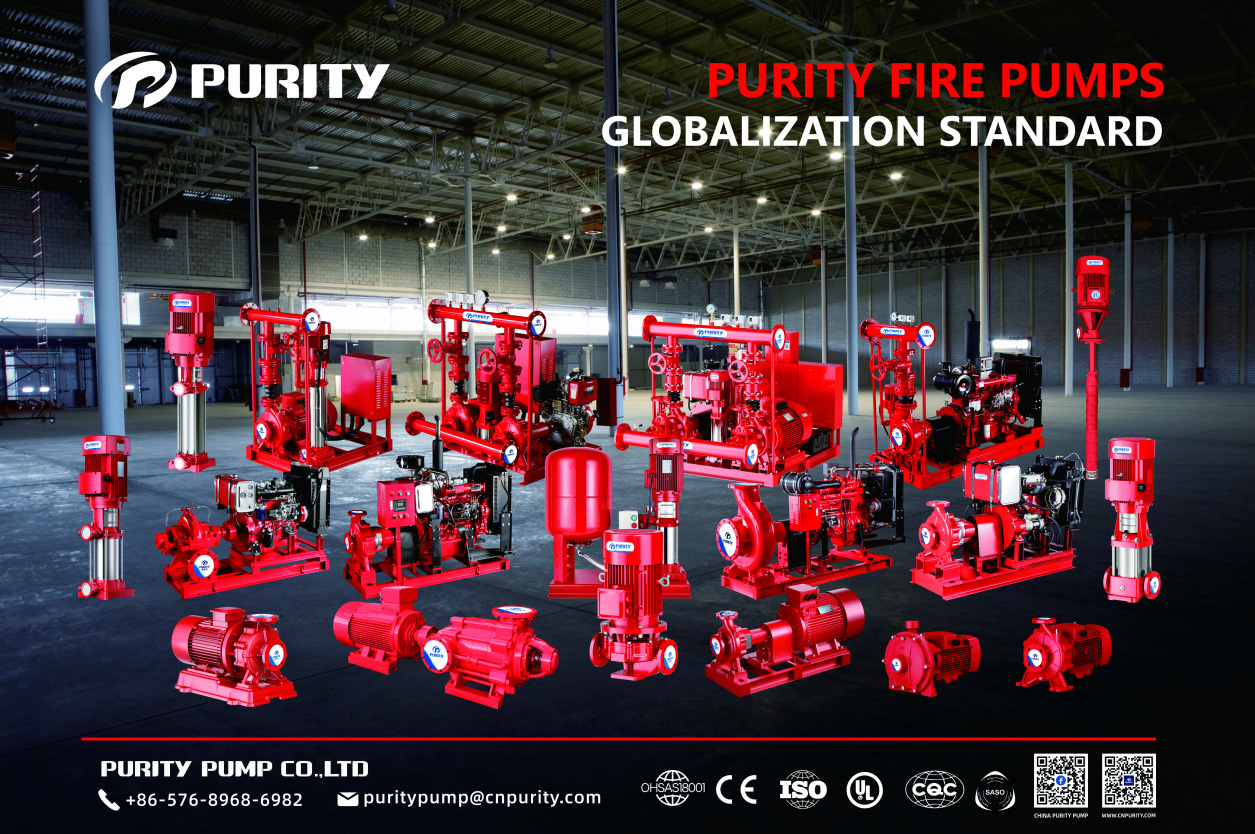In a fire sprinkler system, both the jockey pump and the fire pump play essential roles in ensuring effective fire protection. However, they serve distinct purposes and operate differently. Understanding their differences is crucial for maintaining a reliable fire system jockey pump setup that meets safety standards and optimizes performance.

Figure | Purity Fire Pump Full Range
A jockey pump is a small, auxiliary pump used in a fire sprinkler system to maintain pressure and compensate for small pressure drops. It prevents the fire pump from cycling on and off unnecessarily, reducing wear and tear on the main pump.
1. Pressure Maintenance: The primary function of a fire sprinkler system jockey pump is to keep system pressure stable by addressing minor leaks or fluctuations.
2. Automatic Operation: Jockey pumps are controlled by pressure switches or transducers, which activate the pump when system pressure falls below a set threshold.
3. Small Capacity: Unlike fire pumps, jockey pumps have a lower flow rate and are not designed to supply water for firefighting.
4. Prevents Frequent Fire Pump Activation: By maintaining consistent pressure, the jockey pump ensures that the main fire pump jockey does not activate unnecessarily, extending its lifespan.
While both pumps contribute to the effectiveness of a fire protection system, their roles, capacities, and operations differ significantly.
A fire pump is a powerful pump designed to supply water at high pressure for fire suppression systems, such as fire sprinkler systems and fire hydrants. Fire pumps are activated when the system detects a significant drop in pressure, typically caused by the activation of sprinklers or hose connections during a fire.
1. High Pressure and Flow: Designed to deliver large volumes of water at high pressure to combat fires effectively.
2. Automatic or Manual Activation: Fire pumps start automatically when the system detects water demand but can also be activated manually.
3. Independent Water Source: Typically connected to a dedicated water supply, such as a water storage tank, reservoir, or municipal water system.
4. Complies with Fire Safety Regulations: Must meet stringent safety standards, such as NFPA, UL, or CE certification.
A jockey pump plays a crucial supporting role in a fire pump jockey system by maintaining system pressure and reducing unnecessary fire pump activation. Without a jockey pump, minor leaks or pressure drops could frequently trigger the main fire system jockey pump, leading to increased wear, higher energy consumption, and premature failure.
· Extends the Life of the Fire Pump: By handling small pressure adjustments, a jockey pump prevents the main fire pump jockey from unnecessary cycling.
· Ensures System Readiness: A properly functioning jockey pump fire pump setup keeps the fire protection system at optimal pressure, ensuring immediate response when needed.
· Reduces Energy Consumption: Continuous activation of the fire pump without a jockey pump would lead to higher power consumption and operational costs.
When selecting a jockey pump fire pump combination, several factors must be considered:
· System Pressure Requirements: The fire system jockey pump must maintain pressure within the specified range.
· Capacity and Flow Rate: The jockey pump should be sized appropriately to handle small pressure fluctuations without overworking the main pump.
· Material and Durability: High-quality materials, such as stainless steel shafts and corrosion-resistant components, improve longevity and performance.
· Regulatory Compliance: The jockey pump and fire pump should meet safety certifications such as UL, FM, or NFPA standards.
Purity’s multi-stage jockey pumps stand out due to their high efficiency, durability, and corrosion resistance.
1. High-Quality Materials: Uses 304 stainless steel shafts, ensuring enhanced durability, corrosion resistance, and longer lifespan.
2. Full-Head Design: Supports stable performance across all flow rates, preventing motor burnout and ensuring reliable operation.
3. Energy Efficiency: Designed to optimize power consumption, reducing operational costs over time.
4. Compliance with International Standards: Certified by CE and UL, ensuring top-tier performance and safety.

Figure | Purity Fire Jockey Pump PVE
Choosing between a jockey pump and a fire pump depends on their intended function:
· If you need to maintain system pressure and prevent frequent fire pump activation, a jockey pump is essential.
· If you require high-pressure water supply for fire suppression, a fire pump is necessary.
· For a complete fire protection solution, both a jockey pump fire pump setup is recommended.
Purity specializes in industrial energy-efficient pumps and has 25 years of experience in the field. If you are looking for a high-quality jockey pump or fire pump, contact us today!